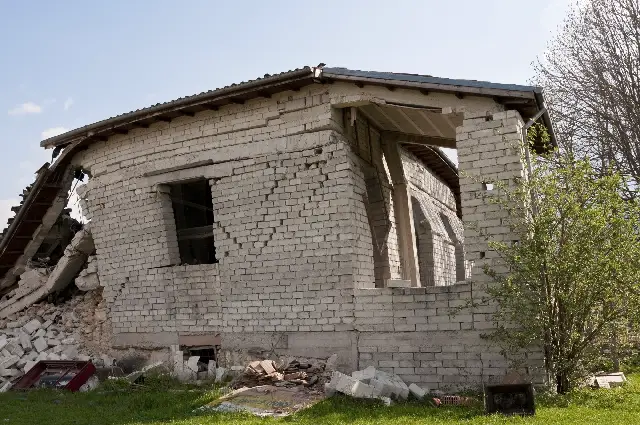Last Updated on July 9, 2023 By Emma W. Thomas
Several reasons can cause a house to sway, including foundation problems, inadequate structural support, high winds, or improper construction. To fix it, start by identifying the root cause through a professional inspection. Common remedies include repairing or reinforcing the foundation, adding additional support beams or braces, and ensuring proper construction techniques.
What causes my house to sway?
Your house could be swaying for different reasons; below are some common reasons why houses sway.
a. Strong wind
The most prevalent cause of house swaying is strong winds. If you live in an area that experiences strong winds, such as Alaska and Wyoming, you might feel your house swaying from time to time. These states experience the most winds with speeds of up to 21.9 mph. That is why most houses in Alaska are built on slits to allow room for swaying in the wind.
House swaying in strong winds is normal and not a source of concern unless the swaying is severe. Most buildings, including skyscrapers, are designed to withstand strong winds and extreme weather conditions—architects and building engineers design these houses to make them sway in strong winds and minimize wind pressure. The swaying is minimal but plays a huge role in minimizing the risk of the building collapsing.
b. Earthquakes
An earthquake is a sudden and severe earthshaking caused by seismic waves. You will mostly feel your house vibrating and swaying when an earthquake occurs. The swaying will be more pronounced if you live on the upper floors, but you might not experience vibrations. An earthquake’s severity depends on its duration, magnitude, and severity.
Small earthquakes have no risk of damage or emergencies and only last a few seconds. On the other hand, large earthquakes last several minutes and make the ground move more violently. If your house is swaying, but all the furnishings are still in place, you are most likely experiencing a small earthquake.
California has been reported to experience the most earthquakes that cause property damage. The South California area experiences about 10,000 earthquakes yearly, although most are too small to be felt.
If you live in Carolina, Nevada, Washington, and other earthquake-prone states, you will likely feel your house swaying from time to time. Most buildings in these regions are built with base isolators and shake absorbers to reduce the swaying and risk of damage significantly

c. Heavy vehicles passing by
Houses near a railway or busy roads used by heavy trucks are most likely to experience house swaying when these trucks pass. The truck’s vibrations mainly cause this type of swaying and subside when there aren’t any vehicles on the road. You don’t need to worry because your house can withstand such vibrations without harming the occupants or destroying property.
A 2017 study by Matec Web of Conferences has shown that vibrations from heavy vehicles and traffic have an impact on the structure of the building. Architects and engineers need to give special attention to buildings near roads to ensure minimal swaying.
d. Vigorous movements in the building
If you live in a storied building, you might feel your house swaying when someone on the upper floor moves vigorously. Moving heavy objects around may create a vibration that makes it feel like your house is swaying. People living in buildings with a gym or fitness center on the upper floors are more likely to experience this type of swaying. You can reduce this swaying by installing insulated floors to prevent vibrations from vigorous movement from being transmitted.
How to Fix House Swaying Problem?

Fixing house swaying requires identifying the underlying causes and implementing appropriate remedies to ensure structural stability. Here are some steps to address and fix house swaying:
- Inspection: Hire a professional structural engineer to assess your house’s foundation, structure, and overall stability. They will identify the root cause of the swaying and recommend suitable solutions.
- Foundation Repair: If foundation issues are causing the swaying, repair work may be necessary. This could involve stabilizing the foundation by installing piers, underpinning, or using other foundation repair techniques.
- Structural Support: Strengthening the structural support of your house can help reduce swaying. This may involve adding additional support beams, braces, or reinforcing existing ones. A structural engineer can provide guidance on the best approach based on your home’s design and requirements.
- Wind Resistant Measures: High winds can contribute to house swaying. Installing wind-resistant features such as hurricane straps, reinforced roof connections, or impact-resistant windows can help mitigate the swaying caused by strong winds.
- Proper Construction Techniques: Ensure that any new construction or remodeling projects adhere to proper building codes and construction techniques. This includes using appropriate materials, and techniques, and consulting with professionals to ensure structural integrity.
- Maintenance: Regular maintenance is crucial for preventing and addressing house swaying. This includes inspecting and repairing any damage promptly, maintaining proper drainage around the foundation, and addressing any signs of structural issues promptly.
- Professional Guidance: Consult with experienced professionals such as structural engineers, contractors, or foundation specialists. They can provide expert advice, design appropriate solutions, and oversee the repair process to ensure it is done correctly.
- Budgeting: Determine the costs associated with the necessary repairs and allocate a budget for the project. The extent of the swaying and required fixes will impact the overall cost, so it’s essential to plan accordingly.
- Permits and Regulations: Depending on your location, certain repairs or modifications may require permits or adherence to specific regulations. Ensure you comply with local building codes and obtain any necessary permits before starting the repair work.
- Ongoing Monitoring: After implementing the necessary fixes, continue to monitor your house’s stability. Regular inspections and maintenance will help identify any potential issues early on, preventing future swaying problems.
Remember, house swaying is a serious concern that should not be ignored. Seeking professional help and addressing the underlying causes promptly will ensure the safety and stability of your home for years to come.
What to do if your house starts swaying
Being in a house that suddenly starts swaying will make you doubt your safety and that of your belongings. Let’s look at some practical steps to take if you notice that your house is swaying.
a. Stay calm and don’t panic
Panicking will hinder you from making sober decisions in case of danger. Try your best to stay calm as you wait for help to arrive. When calm, you will be better positioned to wait out the swaying and record how long it lasts.
b. Get a home inspector to confirm the status of the house.
If your house has never been inspected, you might have to get a building inspector to check for structural shortcomings. A house inspection will help you determine if the problem is fatal or if it can be fixed.
c. If the swaying is vigorous, exit the building immediately following the emergency plan.
Sometimes, your house may sway more vigorously than you expect, and you may risk your life by staying. If you feel unsafe, vacate the premises and seek help when you are already in a safe space. If you cannot leave, hide under any solid furniture such as a table, and hold on to it so that you will be covered from falling objects.
Should I be concerned if my house is swaying?
House swaying is mainly caused by natural causes such as strong winds or earthquakes and should not be a cause of concern. However, if the swaying is severe, it could be a sign of structural weakness, and you will need to consult an architect or building engineer to assess the issue. Always trust your instincts; if you feel that something is amiss, consult a professional.
Why is my house shaking when a heavy truck drives by?
If you live near a road, you must have experienced your house shaking when a heavy vehicle passes by. This shaking is caused by the pressure exerted on the road by the vehicle’s weight. The pressure travels through the ground in the form of vibrations, and you feel it shaking when they get to the foundation of your house.

How much do buildings sway in the wind?
Skyscrapers and tall buildings are designed to withstand strong winds with a swaying allowance. It is usual for these buildings to sway in strong winds because they have an allowance for movement. Skyscrapers can withstand winds of up to 100 miles per hour without much movement inside the buildings. During strong winds, skyscrapers can sway for up to 1.2 meters.
Key insights and takeaway
It may be shocking to feel your house sway, but most times, it is not a cause for concern. Strong winds or small earthquakes mainly cause houses to sway, and almost all houses are designed to withstand this. If you feel that your house is swaying severely, it is advisable to consult a building and construction professional and have your home inspected. Have them assess the house for any structural defects and repair them before the situation becomes fatal.
If you feel unsafe in your house, get out and seek help when you are sure of your safety. Avoid panicking to handle the situation appropriately.
References:
https://forums.whirlpool.net.au/archive/2419031
https://www.city-data.com/forum/san-antonio/1488680-house-shaking-swaying-any-thoughts-probable.html
Emma is a graduate of Domestic Science or Family and Consumer Sciences (Home Economics) from the University of Wisconsin. She has 7 years of experience Working with the strategic section of BestBuy and now writing full-time for Homeeon.
From Managing the Home, Interiors, Cleaning, and Exteriors to Gardening and everything about Making A Home Liveable – is her passion and this Homeeon is the result of this.
Emma loves decorating her home with the best stuff found online. She cares about quality over anything and writes reviews about them here in Homeeon. Get in touch with her over Pinterest.
Keep reading her blogs.

